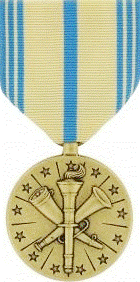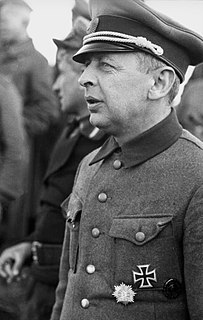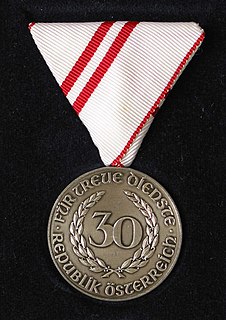The Meritorious Unit Commendation is a mid-level unit award of the United States Armed Forces. The U.S. Army awards units the Army MUC for exceptionally meritorious conduct in performance of outstanding achievement or service in combat or non-combat, the U.S. Navy and U.S. Marine Corps award units the Navy MUC for valorous or meritorious achievement or service in combat or non-combat, and the U.S. Coast Guard awards units the Coast Guard MUC for valorous or meritorious achievement or service not involving combat.
An aviator badge is an insignia used in most of the world's militaries to designate those who have received training and qualification in military aviation. Also known as a Pilot's Badge, or Pilot Wings, the Aviator Badge was first conceived to recognize the training that military aviators receive, as well as provide a means to outwardly differentiate between military pilots and the “foot soldiers” of the regular ground forces.
A Sea Service Ribbon is an award of the United States Navy, U.S. Marine Corps, U.S. Coast Guard, the U.S. Army, and the NOAA Commissioned Officer Corps which recognizes those service members who have performed military duty while stationed on a United States Navy, Coast Guard, Army, or NOAA vessel at sea and/or members of the Navy, Marine Corps or Coast Guard who have been forward-deployed with their home unit.
A "V" device is a metal 1⁄4-inch (6.4 mm) capital letter "V" with serifs which, when worn on certain decorations awarded by the United States Armed Forces, distinguishes an award for heroism or valor in combat instead of for meritorious service or achievement.

A service star is a miniature bronze or silver five-pointed star 3⁄16 inch in diameter that is authorized to be worn by members of the eight uniformed services of the United States on medals and ribbons to denote an additional award or service period. The service star may also be referred to as a campaign star or battle star depending on which award is authorized the star and the manner in which the device is used for the award.

The Good Conduct Medal is one of the oldest military awards of the United States Armed Forces. The U.S. Navy's variant of the Good Conduct Medal was established in 1869, the Marine Corps version in 1896, the Coast Guard version in 1923, the Army version in 1941, and the Air Force version in 1963; the Air Force Good Conduct Medal was temporarily discontinued from February 2006 to February 2009, followed by its subsequent reinstatement.

The World War I Victory Medal was a United States World War I service medal designed by James Earle Fraser.

The Afghanistan Campaign Medal (ACM) is a military award of the United States Armed Forces which was created by Executive Order 13363 of President George W. Bush on November 29, 2004, and became available for general distribution in June 2005. The medal was designed by the U.S. Army Institute of Heraldry.

The Armed Forces Reserve Medal (AFRM) is a service medal of the United States Armed Forces that has existed since 1950. The medal recognizes service performed by members of the reserve components and is awarded to both officers and enlisted personnel. The medal is considered a successor award to the Naval Reserve Medal and the Marine Corps Reserve Ribbon, which were discontinued in 1958 and 1967, respectively.

The Army of Occupation Medal is a military award of the United States military which was established by the United States War Department on 5 April 1946. The medal was created in the aftermath of the Second World War to recognize those who had performed occupation service in either Germany, Italy, Austria, or Japan. The original Army of Occupation Medal was intended only for members of the United States Army, but was expanded in 1948 to encompass the United States Air Force shortly after that service's creation. The Navy and Marine equivalent of the Army of Occupation Medal is the Navy Occupation Service Medal, which features the same ribbon with its own medallion and clasps.

Insignias and badges of the United States Navy are military badges issued by the United States Department of the Navy to naval service members who achieve certain qualifications and accomplishments while serving on both active and reserve duty in the United States Navy. Most naval aviation insignia are also permitted for wear on uniforms of the United States Marine Corps.

Insignia and badges of the United States Marine Corps are military "badges" issued by the United States Department of the Navy to Marines who achieve certain qualifications and accomplishments while serving on both active and reserve duty in the United States Marine Corps.

The awards and decorations of the Civil Air Patrol are "designed to recognize heroism, service, and program achievements" of members of the Civil Air Patrol (CAP) of the United States of America. The CAP is the official auxiliary of the United States Air Force, and these awards are made to improve the esprit de corps of members. These awards are all worn in the form of medals or ribbons and all are considered civilian decorations. Civil Air Patrol regulations allow them to only be worn and displayed on appropriate CAP uniforms. In order to be considered for one of these awards, an individual must be a member in good standing of the Civil Air Patrol at the time of the act being recognized. There is a statute of limitations for these awards and all recommendations must be submitted within 2 years of the act being performed. It is possible for the next of kin of deceased persons to be presented awards to which a member was entitled, but which he or she did not receive. Award review boards are established at the region, wing, group, and squadron levels to consider recommendations for all awards and decorations.

The Austrian Military Police (German: Militärpolizei) is the branch within the Austrian Armed Forces tasked with law enforcement and the protection of the forces, military events and Austrian Armed Forces property. The increasing number of international operations with the participation of Austrian soldiers and new threat scenarios hugely expand the spectrum of tasks.

Medal for Gallantry and Merit for Members of the Eastern Peoples was a military and paramilitary award of Nazi Germany. Established on 14 July 1942, it was bestowed on personnel from the former Soviet Union, who volunteered to fight alongside German forces. The Medal is sometimes called the Ostvolk Medal or Eastern People's Medal,.
The honours system in the Republic of Austria is a means of rewarding individuals' personal achievement, or service to Austria by state decorations and medals.
The Austrian army of the Second Republic has 21 military ranks. Gorget patches generally show corps colors (Waffenfarbe), as is presented below.
The Austrian Armed Forces Operations Medal was established in 2001 to recognize operational service by the Military of Austria. The medal is 40 mm wide and round, suspended from a ribbon that varies depending on the type of operation.

The Militia Medal is a military medal of Austria awarded to members of the militia in recognition of services rendered in militia activities. It can only be awarded once.

The Law Enforcement Merit Decoration is a state award of the Republic of Austria, established by federal law on December 1, 1985.












